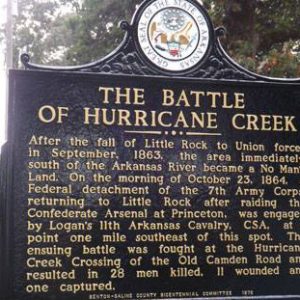calsfoundation@cals.org
Poe's Battalion, Arkansas Cavalry (CS)
Poe’s Arkansas Cavalry Battalion was a Confederate cavalry unit that served in the Trans-Mississippi Department, entirely in Arkansas, during the American Civil War. It participated in military engagements at Mount Elba, Easling’s Farm, Poison Spring, Marks’ Mills, and Hurricane Creek, as well as undertaking scouting and picketing duties in southern Arkansas. During Price’s Missouri Raid in 1864, it was one of the few cavalry units left behind to keep watch over Federal troops in Arkansas.
The unit was organized in November 1863 by a former Saline County judge, Major James T. Poe of the Eleventh Arkansas Infantry. Poe had journeyed home from Louisiana to remove his family farther south from Saline County after the fall of Little Rock (Pulaski County) to Union forces in September 1863. He raised the unit to help protect local families in the area. The battalion, although officially designated Poe’s Arkansas Cavalry, was often referred to as the Eleventh Arkansas Cavalry. After the return of Colonel John L. Logan of the Eleventh Arkansas Infantry to Arkansas, it was commonly referred to as Logan’s Cavalry. Primarily composed of former members of the Eleventh and Seventeenth Arkansas Mounted Infantry who had been captured at Port Hudson and other locales who were paroled back to Arkansas, it also included deserters and previously discharged soldiers, all of whom were organized into the battalion. The battalion was assigned to Colonel William A. Crawford’s Cavalry Brigade of Major General James F. Fagan’s Division.
Stationed at Monticello (Drew County) in March 1864, the battalion, as part of Crawford’s Brigade along with Dockery’s Brigade, attacked and attempted to destroy a Union force under Colonel Powell Clayton at Mount Elba (Cleveland County) on March 30. Facing infantry and artillery behind hasty defensive works, the Confederates, despite their repeated assaults, were defeated, forcing a hasty retreat toward Monticello. While the Confederates were moving into position the day prior, unknown to them, Clayton’s Cavalry had attacked and captured their entire wagon train at Easling’s Farm on Longview Prairie in Ashley County. This included more than 300 men, thirteen of whom were dismounted members of Poe’s Battalion.
During the April 1864 Camden Expedition, the battalion, as part of Major General Sterling Price’s Cavalry, operated against Brigadier General Frederick Steele’s forces in southern Arkansas. Poe’s Battalion, as part of Crawford’s Brigade, engaged and assisted in the destruction of a Union supply train at Poison Springs on April 18, 1864. Seven days later, they engaged a large Federal force at Marks’ Mills, assisting in the complete destruction and capture of the entire force. When Steele’s army retreated back to Little Rock after the Engagement at Jenkins’ Ferry, the battalion continued to scout and picket areas of south-central Arkansas for the remainder of the summer.
In August 1864, Major General Price started north on his disastrous Missouri Raid, leaving only a small cavalry force in Arkansas to monitor the Union army at Little Rock and Pine Bluff (Jefferson County). Poe’s Battalion was one of the few to remain behind and was placed under the command of its former commander, Colonel John L. Logan. Operating out of Princeton (Dallas County) and Tulip (Dallas County), the battalion conducted scouting operations and patrolled as far as the Saline-Pulaski county border to south of Pine Bluff.
On October 21, Logan’s force was attacked by a Union scouting party sent to Princeton to destroy Confederate weapons. The Union force then headed toward Little Rock. Logan hurried his men forward and successfully prepared an ambush along Hurricane Creek on the Camden Trail near present-day Bryant (Saline County). On October 23, as the Union column crossed Hurricane Creek, the Confederates opened fire. The Confederates failed to destroy the column and eventually withdrew. Union dispatches reported losses of two killed and eleven wounded, while they captured one enemy and found twenty-seven dead on the field. The lopsided casualties may be the result of execution of Confederate wounded and captured. Colonel Logan filed the claim that his men had been summarily executed after falling into the hands of the enemy and personally delivered his report, under flag of truce, to Union authorities. Brigadier General Steele claimed no knowledge of such an incident but promised to investigate. No further information is found regarding this incident.
On May 22, 1865, Poe’s Battalion was stationed at Darby’s Ferry on the Red River in Arkansas, where Colonel Logan furloughed the men home, advising them to surrender themselves to the nearest Union force and receive their paroles; most simply returned to their homes without any official surrender.
For additional information:
Bearss, Edwin C. Steele’s Retreat from Camden and the Battle of Jenkins’ Ferry. Little Rock, AR: Eagle Press, 1990.
Poe, J. C., comp. and ed. The Raving Foe: The Civil War Diary of Major James T. Poe, C.S.A., and the 11th Arkansas Volunteers, and a Complete List of Prisoners. Eastland, TX: Longhorn Press, 1967.
Rushing, Anthony C. Ranks of Honor: A Regimental History of the Eleventh Arkansas Infantry Regiment and Poe’s Cavalry Battalion, C.S.A., 1861–1865. Little Rock: Eagle Press, 1990.
The War of the Rebellion: A Compilation of the Official Records of the Union and Confederate Armies. Washington DC: Government Printing Office, 1880–1901.
Anthony Rushing
Benton, Arkansas
 Civil War through Reconstruction, 1861 through 1874
Civil War through Reconstruction, 1861 through 1874 Military
Military ACWSC Logo
ACWSC Logo  Hurricane Creek Marker
Hurricane Creek Marker  James T. Poe
James T. Poe 




Comments
No comments on this entry yet.